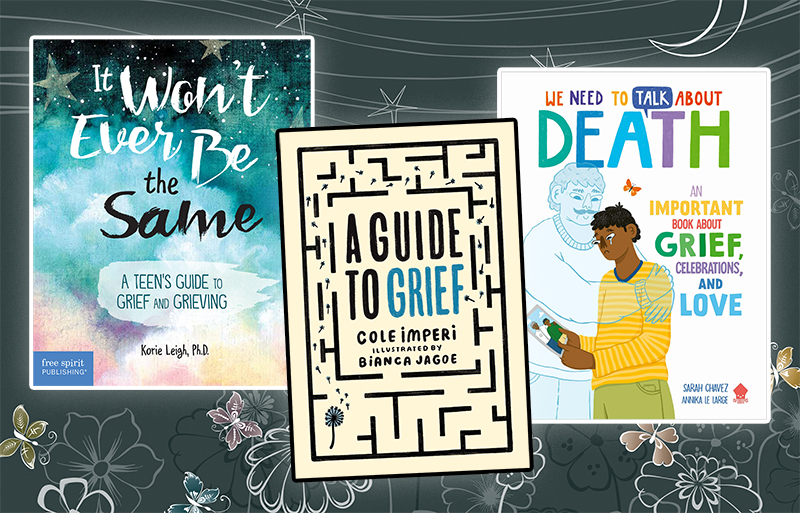3 Grief Guides for Tweens and Teens
These guides compassionately provide support, resources, and coaching for young people navigating death and loss.

We Need to Talk About Death: An IMPORTANT Book About Grief, Celebrations, and Love by Sarah Chavez. illus. by Annika Le Large. Neon Squid. ISBN 9781684493753.
Gr 5 Up–Death is rarely a happy topic, but in this middle grade text, it is explained with friendliness and warmth. In 27 concise chapters, Chavez covers everything from a straightforward definition of death; ways different cultures respond to loved ones’ deaths; an exploration of various death deities and mythologies; and necrotech, technology dealing with death. Tips for memorials (for both pets and people) are offered here. Burial methods from around the world are delved into. Le Large’s illustrations are lightly stylized and multicultural, reminiscent of surrealist artist Jim Nutt’s art. Pages are busy and inviting, although the overall design creates a feeling of calm. There’s a lot of information packed into this easy-to-read book. A helpful glossary and index round out the text. VERDICT Chavez’s prose and Le Large’s cartoon illustrations work well together to lighten up what is most often a difficult topic.
It Won’t Ever Be the Same: A Teen’s Guide to Grief and Grieving by Korie Leigh. Free Spirit. ISBN 9798885543842.
Gr 7 Up–A gentle and sensitive resource for grieving young people. Grief counselor Leigh first explains how readers can utilize the book, complete with helpful symbols and succinct explanations. She breaks down neuroscience, grief, and different types of losses in a digestible and tangible way that will leave teens feeling confident in their knowledge about their own brain and grief. There are quotes and artwork throughout from real teens, which adds to the comforting tone of the narrator. Leigh includes many examples of ways young people can help learn about themselves and their own grief, how to manage their feelings, and how to nurture their connection with their loved ones who have passed on (if they decide to do so) through activities like body mapping, journaling, and support bracelets. The guide features a purple and teal color palette. Visual aids of the body and the brain bring home the message, and spot art of flowers, hearts, and stars make this age appropriate. Back matter includes an index and organizations and websites that readers can consult. VERDICT This is a wonderful book that no one wants to have to read, but is an accepting and supportive resource to help in tough times. Purchase for teen collections.
A Guide to Grief by Cole Imperi. illus. by Bianca Jagoe. Kids Can. ISBN 9781525309656.
Gr 5 Up–A tome for late elementary and middle grade children on processing and living with grief. Thanatologist Imperi provides tools to deal with shadowloss (experiences like moving to a new town or having parents divorce), as well as deathloss (death of a loved one). The focus is on living with grief and processing emotions instead of trying to ‘fix’ feelings or force a grief experience to look a specific way. There are also chapters to help navigate when a friend or an adult is grieving. Some of the content seems like it would be more applicable to an adult who is reading the book along with a young person, but it is integrated in a fairly accessible way. There is also a section for caretakers and a list of resources, including international hotlines. Jagoe’s illustrations are limited and in black and white, but they do make use of creative fonts to maintain visual interest throughout the book. Artwork depicts children with a variety of gender identities, races, cultural backgrounds, and religions. VERDICT Recommended. This is an age-appropriate and culturally sensitive introduction to grief loss that gives some scientifically backed strategies to support young people, their friends, and families.
Read Good Grief: Middle Grade Authors Normalize Loss
RELATED
Babies at the Zoo
Construction
Hooray for My Brain!
The job outlook in 2030: Librarians will be in demand
The job outlook in 2030: Librarians will be in demand
ALREADY A SUBSCRIBER? LOG IN
We are currently offering this content for free. Sign up now to activate your personal profile, where you can save articles for future viewing






Add Comment :-
Be the first reader to comment.
Comment Policy:
Comment should not be empty !!!